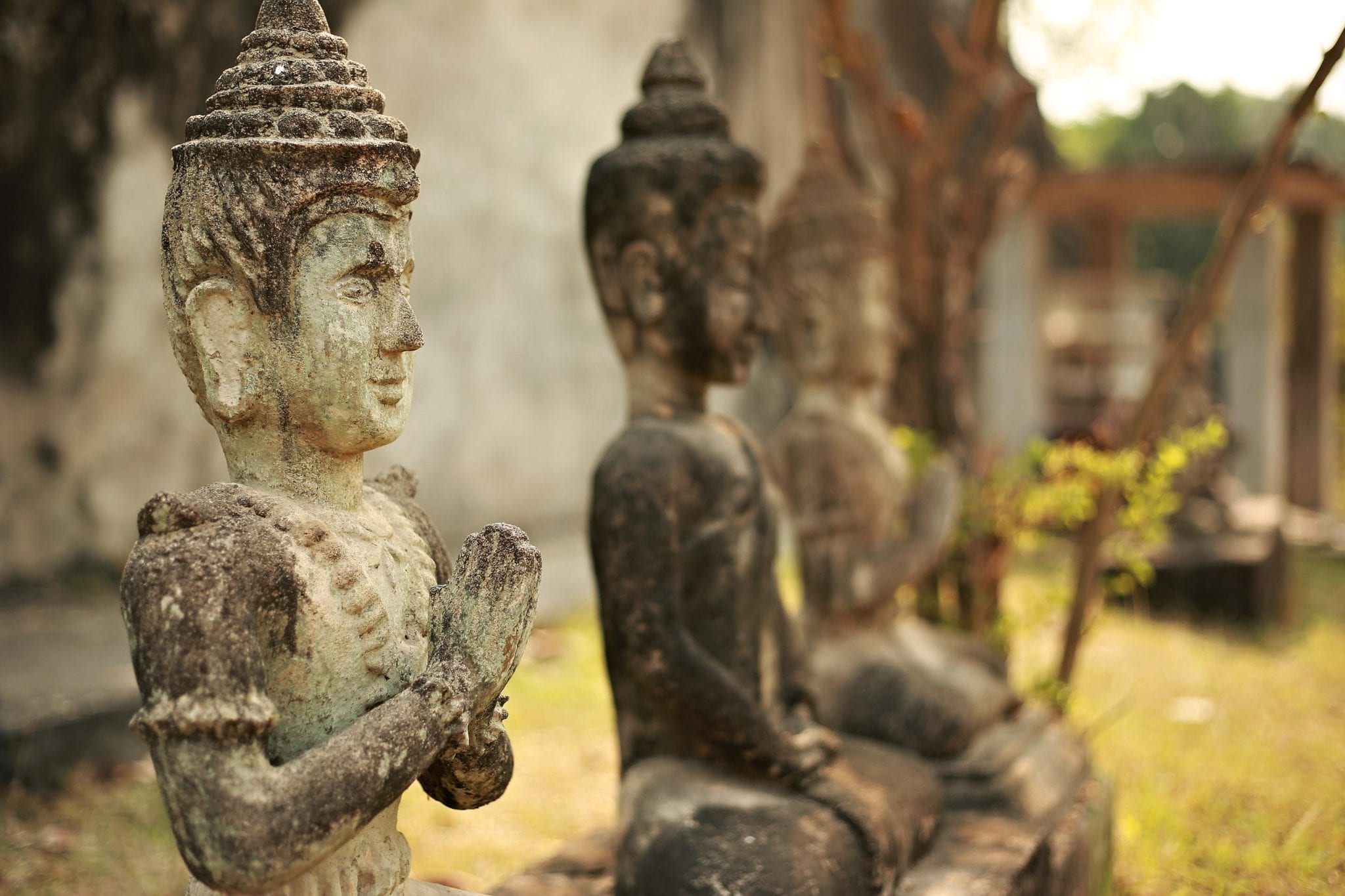
Vientiane was, to say the least, a disappointment. Our guesthouse was cheap and in a good location, but came with several catches. The mix of old hardwood and rattling doors meant it felt like we were staying in a place that was a mix between my Great Grandma Grant’s house and an asylum – seeing someone in a straightjacket sitting in our high-ceilinged, 60s-tiled bathroom wouldn’t have come as a complete shock. The mattress was a super deluxe model from the SEA Hard Mattress Superstore. The owners were so crotchety that I couldn’t resist the childish urge to stick my tongue out in their direction once we’d rounded the corner and headed for the stairs. Cheap, but you get what you pay for.
We sweated it out in weather that would make Hades feel like Norway in February. Daily visits to the local pool were a must, and it was there that we met the 5ish year old Lao version of the Swedish Chef. He played with me in the kiddie pool (I was there because I could hang my arms out of the pool and read while keeping cool) for close to two hours and wasn’t quiet once during that time, despite never making any sounds that could be distinguished as actual words – in Lao or English. When we left, he waved us off from the gate, chirping at us while we walked the entire length of the national stadium with huge grins on our faces.
We spent one unexpectedly long morning (due to tuk tuk suspension troubles) at the Buddha Park, enjoying the huge variety of statues there. On the way back, we were both quite shaken after witnessing a transport/motorcycle accident that involved three young men being swept into and trapped under the transport where the bed meets the cab after trying to overtake the truck while it was making a left turn. Much to our relief, all three miraculously scrambled out from underneath and managed to walk away from an accident that should have killed them.
After spending so many hours on Lao buses, we decided it was time to rethink our travel plans and, as a result, had to eliminate the 13-hr trip from Phonsavan to the remote town of Sam Neua. We had neither the time nor patience to travel the mountainous 330km path between the two locations, despite the strong urge to get so far off the beaten path. We also decided to rent a car and drive ourselves to Phonsavan to visit the Plain of Jars.
By bus, Phonsavan is 11 hours from Vientiane. It’s only 400kms. To help you with the math, that’s an average travelling speed of 36kms/hr. This gives most normal people some indication of the state and style of the roads. Not us. We still figured it would be quicker than the seven hours in which we managed to get there. So, once again, we arrived in a new town in the dark, but were at least fortunate enough to have our own wheels, so finding a guesthouse with a room available (there was a BIG wedding in a small town) wasn’t as arduous as it could’ve been.
Bags dropped and room paid for, we set off in search of food and settled on a local pho (‘fuh’, not ‘foe’) restaurant. For a measly 10,000 kip ($1.25), we were each presented with a bowl of noodle soup so large there was a brief conversation about whether or not it would be theoretically possible to wash one’s hair in it. Prospects were good. We did a rather pathetic job of eating the soup – each of us had more than half a bowl left and I was so full it felt like my eyeballs were floating in broth. Just as we were lamenting the amount of food about to be wasted, a young boy came up to the half-wall behind me and begged for food. Normally, this presents a bit of an ethical debate, but in this case, we were happy to let the kid hit the jackpot. I stood up and carried my bowl, spoon and chopsticks over to the wall and quietly handed them over. He crouched down in the dark on the other side and went to work on the contents. Five minutes later, the only remnants of my meal were three slices of tomato and three tablespoons of broth, which he then dumped into Rich’s bowl when I brought that over. He gave us a wide-eyed thank you as he returned the second empty bowl a few moments later and we were pleased to have been able to help out someone who was clearly very hungry and leave with full stomachs ourselves. We passed the boy on the sidewalk a few moments later and he gave us a huge grin and patted his belly. Happy camper.
We were up by 5am in order to get to the Plain of Jars sites in time for daybreak. This was partly strategic – I was hoping for a pretty sunrise followed by good light for photographing the sites; and partly out of necessity – if we didn’t start early, we’d never make the return journey in time to return our truck. The Plain of Jars isn’t quite a self-explanatory name; it isn’t a single plain, nor are they ‘jars’ as a regular person would expect – but then “Random Fields of Big Stone Urns” doesn’t have quite the same ring to it… There are dozens of sites with varying number of jars, each consisting of anything from a handful to upwards of 250 giant stone urns. The purpose of the urns is still a mystery; locals say they were for making lao lao, the local fermented rice wine, but archaeologists have found bones in some urns, suggesting a funereal purpose.
We visited the two largest sites (1 and 3), which have been cleared of nearly 180 pieces of unexploded ordinance between them, more than 70% of which came from Site 1. We had a peaceful walk to Site 3 along raised dirt paths through rice paddies as the sky brightened. We weren’t treated to a sunrise (the sky gradually brightened but the number of controlled fires in the surrounding areas meant there was far too much residual smoke haze), but we did have both sites entirely to ourselves, which gave everything a slightly spooky air.
After a wander through two sites, it was time to make a beeline back to Vientiane – or as much of a beeline as possible when travelling on twisting mountain roads that are more pothole than pavement.
The drive took us through remote villages that emphasized the simplicity of life in Laos. No motor vehicles, no electricity, one spigot along the road or near the village for everyone to collect bathing or cooking water. Everyone had a job – anyone who could walk but wasn’t leaving the village (ie young children and the elderly) had an infant strapped to their back as “daycare”; those who were strong enough were given a sack with a strap for placing across the forehead to distribute the weight of the produce, firewood or charcoal being collected from the surrounding hills. This was subsistence living at its most extreme. Laundry was done in buckets and hung out on lines in front of the house. Given the dusty roads, it wasn’t difficult to believe that the clothes would be dirty before they’d even had a chance to think about drying.
While driving through one village, we were both confounded by a peculiar sight: two girls, probably in their early teens, were running down the road, sandy blonde hair streaming behind them. We both did double takes and each then looked at the other for confirmation of what we’d just seen: two distinctly blond, distinctly Laotian girls in a small village in the middle of nowhere. No white people to be seen anywhere. We’re still puzzled by this little genetic feat.
We detoured via Vang Vieng to admire the karst formations rising into the haze and, having seen the town and the river, felt at ease leaving it behind without worrying about missing out on much. It was like a riverfront version of Sihanoukville, but we’d managed to get there early enough in the day for the drinking/drugs scene to not be overly visible yet.
We made it back to Vientiane, grateful to be getting out of the truck and immensely thankful that we didn’t see any more motorcyclists with poor driving skills like we had on the way back from the Buddha Park. We had a few hours to recover from 14 hours of full-attention-required travel and then it was time to hop on a night bus and try to get to sleep as quickly as possible; the night bus would be retracing a full 200kms of our journey and we already knew what kind of roads were in store. We were happy to be getting on the road and away from Vientiane, and hopeful that our next destination would be both more welcoming and more interesting. In the meantime, shut eye was advised.
Grateful for: sleeper buses with seatbelts



